what colors do you use to make green
Green has always been a troublesome colour for beginners. Why that is the case, I'thou non certain. It may accept something to do with a lack of understanding of how to mix color. Or maybe it has something to do with how we really perceive green.
As Pablo Picasso once said:
They'll sell you thousands of greens. Veronese green and emerald dark-green and cadmium green and any sort of greenish y'all like, only that particular green, never.
In whatever case, mixing dark-green is no different from mixing whatever other colors. In this post, I am going to discuss how to mix green and in item, how to mix a vivid green.
What Colors Make Green?
It is pretty common knowledge that yellow and blue make green. If yous are non familiar with basic colour mixing, then a unproblematic way to think about information technology is if you mix two colors, then the colour you get will usually be between those colors on the colour bicycle.
And then if you mix yellow with blue, then you volition get the color between them on the color wheel, which is dark-green. This is a very basic explanation of how subtractive color mixing works.
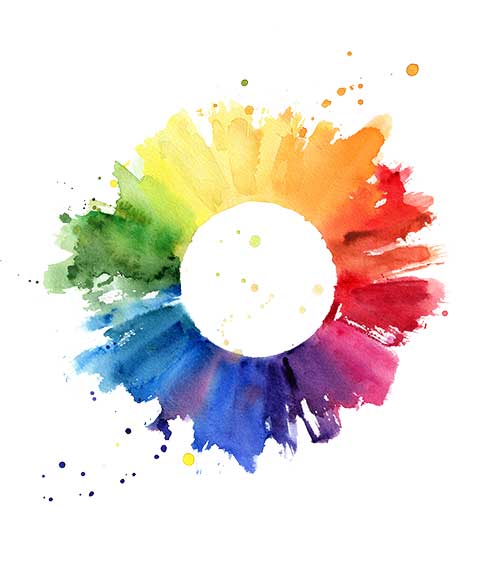
But the real question is non "what colors make light-green?" It is, "what type of green will you make by mixing a xanthous and a blue?"
Yous see, as painters, we do not have an absolute xanthous or bluish. We accept many dissimilar variations, such every bit ultramarine blue, cobalt blue, manganese blue, xanthous ochre, cadmium yellow, cadmium yellow calorie-free, cadmium yellow deep, naples yellow, and and so on.
These colors belong to either the blue or xanthous families. But they each lean towards another color, that is, they take a color bias.
For case, ultramarine bluish leans towards crimson, but manganese blue leans towards yellowish.
So almost of the primary colors we utilize on our palettes are positioned at dissimilar places on the colour wheel. This is a very important concept to understand, as it determines what colors you are actually capable of mixing.
Colour is not and then simple that you are able to just grab any red, blue and yellow and mix all the colors of the rainbow similar some color theory suggests. Colour in painting is non that straightforward.
Color Bias - Cool And Warm Primary Colors
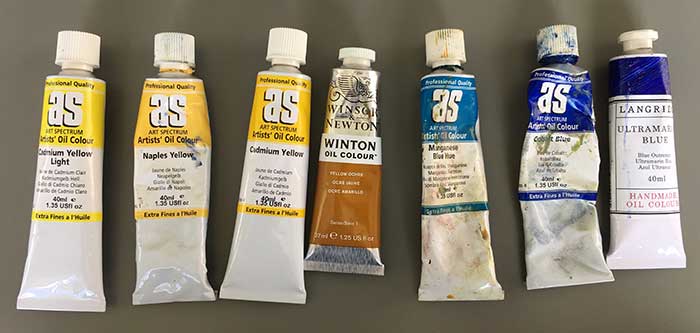
An interesting do you can do is to go through your studio and circular up all the different reds, blues and yellows you lot accept. Above is a photograph of all the different yellows and blues I found.
These are the paints:
- Cadmium yellow light
- Naples yellow
- Cadmium yellow
- Yellow ochre
- Manganese blue
- Cobalt blue
- Ultramarine blue
So when someone asks "what colors make greenish?", you can run across why it is a difficult question to respond. Yellow and blue is a broadly right respond, but that does non tell us what we really want to know. There are so many unlike types of yellows and blues to choose from.
Each of these colors are positions at different locations on the color cycle. You could say that each of these paints are either warm or cool versions of yellowish or blue. Just remember, it is much more effective to think about color temperature as a relative term rather than an accented term. Then I do not like to refer to a sure xanthous equally being either warm or cold. I prefer to recollect of a yellow every bit being either warm or absurd relative to the other yellows.
When you lot accept a few dissimilar yellows and dejection, what you can exercise is rank them in terms of relative color temperature.
In theory, the cooler yellows will have more blue and lean towards green. The warmer yellows will take more ruby-red and lean towards orange.
The cooler blues will have more yellow and lean towards dark-green. The warmer dejection have more red and lean towards violet.
So if I rank the yellows in terms of colour temperature from cool to warm I get - cadmium yellow light, cadmium yellow, naples yellowish, yellowish ochre.
If I rank all the blues I go - manganese blue, cobalt blue, ultramarine blue.
Once you lot understand these colour biases, then yous will have a much easier time mixing vivid secondary colors. Y'all see, to mix a brilliant secondary colour y'all demand to mix just two chief colors together.
Only what happens when you lot mix a warm yellow with a warm blue? Well, by doing that you are mixing a yellow and a blue which both take a affect of red in them. And so you are mixing all three primary colors to some extent. What happens when you mix all iii chief colors together? You get mud (when enough of each color is present).
Exercise - Mixing Different Greens
Later on rounding upwards all the unlike yellows and dejection, I decided to practise a bit of a mixing exercise to see the dissimilar greens I am able to brand.
My goal is to effort and mix a bright green. This is a struggle for many artists. Most of the time your attempt at a vivid green results in something which is much closer to a dirty olive color.
The colors on my palette below are in this order: titanium white, cadmium yellowish light, cadmium yellow, naples xanthous, yellowish ochre, manganese bluish, cobalt blueish and ultramarine bluish.
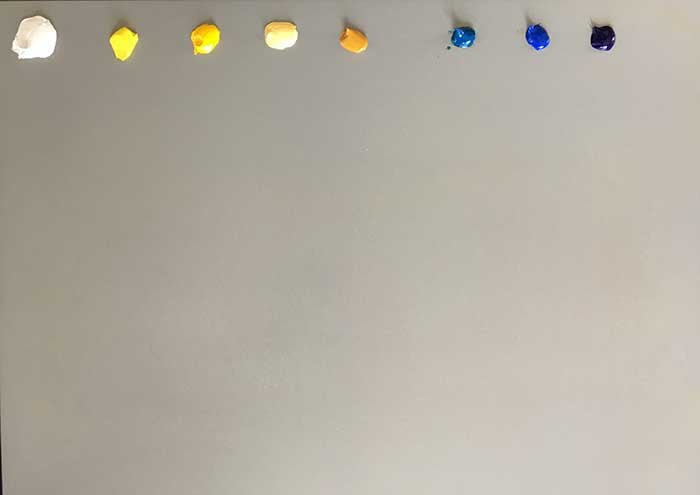
I commencement by mixing the most vivid green possible with the colors on my palette. To do this, I mix the coolest yellow with the coolest bluish. In this example, it is cadmium yellow lite and manganese blue.
These two colors are positioned closest on the color wheel compared to all other combinations of the yellows and blues on my palette. Cadmium yellow light leans towards greenish and and so does manganese blue. Neither color contains much, if any, red.
The resulting color is a dainty, vivid dark-green.
Cadmium yellow and manganese bluish besides mix into a vivid light-green, only it is slightly warmer and less saturated.
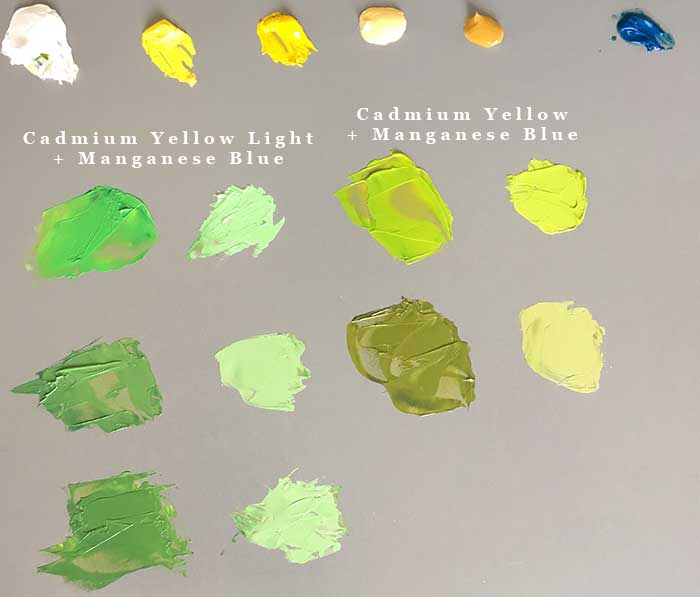
All the other color combinations are considerably less saturated. This is considering more cerise is present in these mixtures.
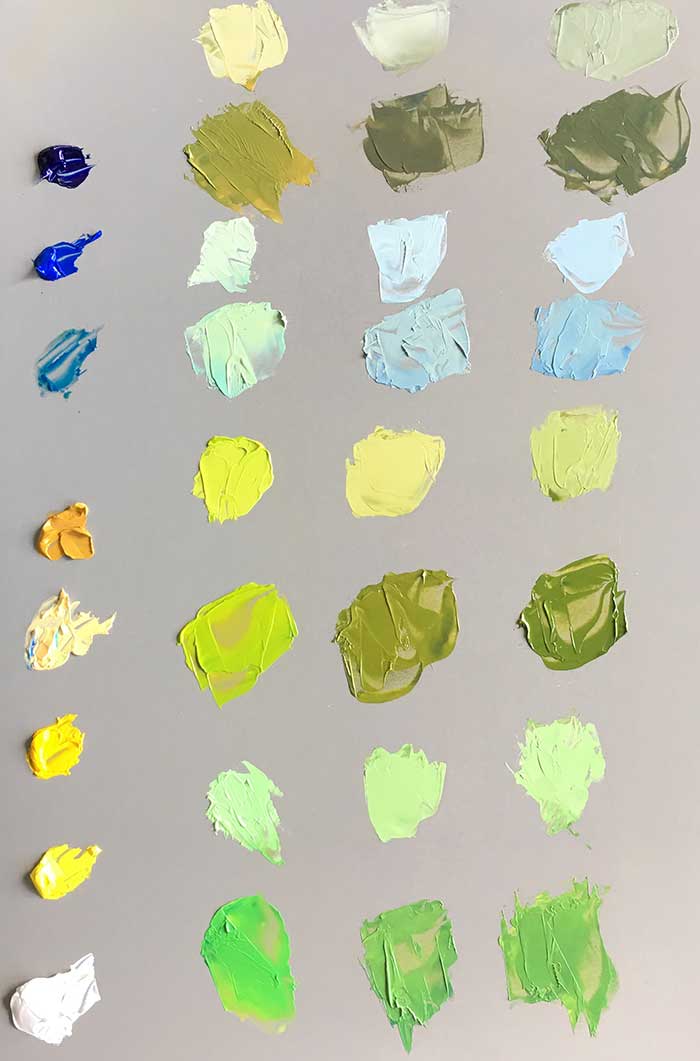
Cease Result - Which Colors Produced The Most Vivid Green?
Here is the most brilliant green I was able to mix using the yellows and dejection from my studio. I mixed this by combining cadmium yellow light and manganese blue.
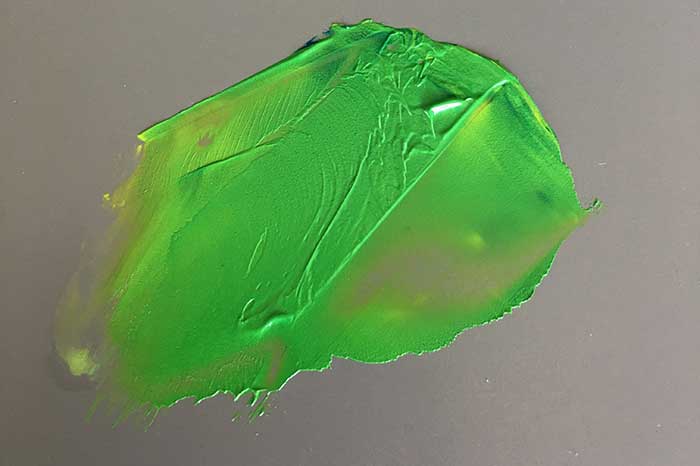
Which Colors Produced The Most Tedious Light-green?
Not surprisingly, the dullest green was produced by mixing yellow ochre and ultramarine bluish. Both these colors are relatively warm (contain some red). In addition, the yellow ochre is of low saturation.
The resulting greenish is almost but a grey-green.

What You Can Learn From This
The big takeaway from this mail is that you lot need ii things to mix bright secondary colors:
First, yous need ii colors which have a high saturation (chroma). It seems obvious, but y'all are not able to mix two colors of a depression saturation and somehow get a color of a higher saturation.
2d, yous need to avoid mixing all three of the master colors together. So y'all need to mix two chief colors which lean towards the color you want to mix on the color wheel.
(If y'all desire to learn more virtually color mixing and painting in full general, I invite yous to join my free email course, vii Days to Better Paintings).
Dark-green in Practice
MyMinnippi painting was a great do in mixing different greens, from the deadening greenish trees in the back to the line of brilliant greenish around the middle. Y'all tin can see the painting come together in this video:
Thank you for Reading!
Thank you for taking the time to read this post. I appreciate it! Feel free to share with friends. If yous want more painting tips, cheque out my Painting Academy course.
Happy painting!

Dan Scott
Draw Pigment Academy
bradleypasioned87.blogspot.com
Source: https://drawpaintacademy.com/how-to-mix-green/
0 Response to "what colors do you use to make green"
Post a Comment